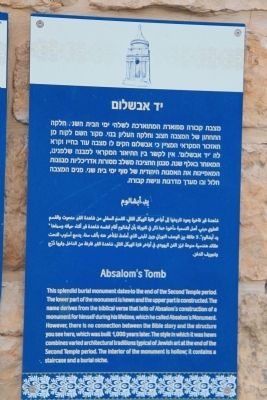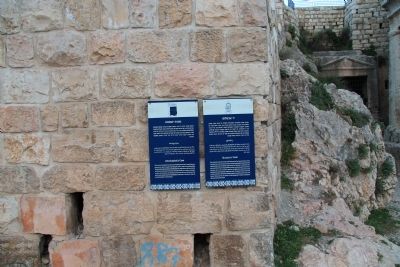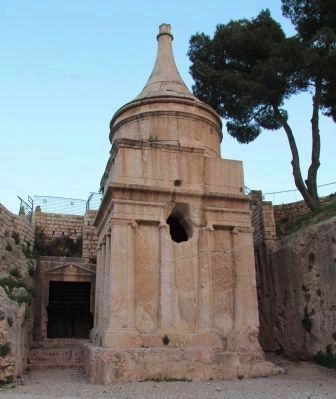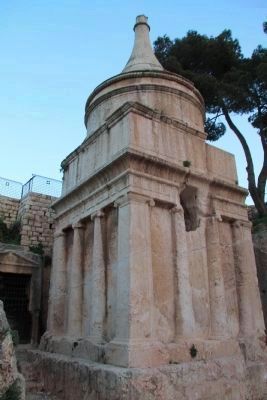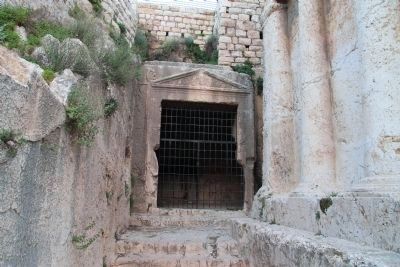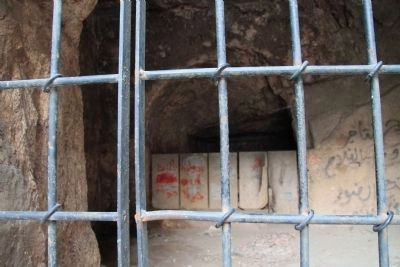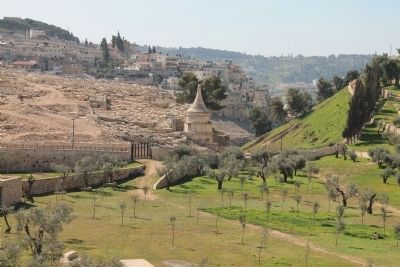Jerusalem, Jerusalem District, Israel — The Middle East (West Asia)
Absalom's Tomb
Topics. This historical marker is listed in these topic lists: Cemeteries & Burial Sites • Man-Made Features.
Location. 31° 46.641′ N, 35° 14.324′ E. Marker is in Jerusalem, Jerusalem District. Marker can be reached from Derech Jericho just south of Derech HaOfel, on the right when traveling south. I used the HMDB.org, Google map feature to help me identify locational information. This marker is located off road, in what I will call a community park area, along a well traveled walkway named Derech HaShiloah. This walkway begins along the west side of the Derech Jericho roadway and drops down into the Kidron Valley. Both the historical marker and the rock cut burial cave that the marker features are located at the base of the Kidron Valley. Touch for map. Touch for directions.
Other nearby markers. At least 8 other markers are within walking distance of this marker. Jehoshaphat's Cave (here, next to this marker); Gethsemane (about 210 meters away, measured in a direct line); The Eastern Huldah Gate (approx. 0.3 kilometers away in Israel); Meeting place of three fortification elements (approx. 0.3 kilometers away); Ritual Baths and Water Conduits (approx. 0.3 kilometers away); Double Gate Monumental Stairs and Observation Plaza (approx. 0.3 kilometers away); Preserved buildings of the First Temple Period (tenth-sixth centuries BCE) (approx. 0.3 kilometers away in Israel); A large cistern that dates back to the Second Temple period (approx. 0.3 kilometers away in Israel). Touch for a list and map of all markers in Jerusalem.
More about this marker. IIn a historic valley, lined with an immense number of ancient grave sites, the subject of this historical marker stands out as a significant feature. The subject of this historical marker is actually an immense, rock cut, late Second Temple Period (Herod to First Jewish Revolt), burial complex. The burial complex was cut into a limestone escarpment that juts out of the eastern side of the base of the Kidron Valley. According to the Jerusalem Archaeological Park website, "The
original entrance, in the facade of the rock-cut cube, leads to a small burial chamber located in its upper part. The chamber contains two benches on which the deceased were placed, probably in sarcophagi or ossuaries. The holes in the walls of the monument were made many centuries ago by tomb robbers."
Regarding Absalom's Tomb. Absalom's Tomb is one of the most impressive of the ancient tombs of wealthy Jewish families that lived in Jerusalem during the Second Temple Period. According to the Jerusalem Archaeological Park website, this is contrary to, "…a popular Jewish tradition that associates the monument with Absalom, King David's rebellious son, of whom the Bible says: 'Now Absalom in his lifetime had taken and reared up for himself the pillar, which is in the king's dale; for he said: I have no son to keep my name remembrance; and he called the pillar after his own name; and it was called Absalom's monument unto this day" (2 Samuel 18: 18).
The website goes on to say that, "The identification is, of course, erroneous, for the monument was built about one thousand years after the time of Absalom. Nevertheless, it was customary in Jerusalem, from the Middle Ages to recent generations, for whoever passed by the monument to throw a stone at it, as if to proclaim the fate of a rebellious son.
Also see . . .
1. Tomb of Absalom. This is a link to information provided by Wikipedia, the free encyclopedia. (Submitted on March 24, 2013, by Dale K. Benington of Toledo, Ohio.)
2. Tombs in the Kidron Valley. This is a link to information provided by a website entitled Jerusalem 101 (Submitted on March 24, 2013, by Dale K. Benington of Toledo, Ohio.)
3. Tomb Of Absalom I. This is a link to a panoramic, 360 degree photograph, featuring Absalom's Tomb, provided by jerusalem360.com. (Submitted on March 24, 2013, by Dale K. Benington of Toledo, Ohio.)
Credits. This page was last revised on January 31, 2022. It was originally submitted on March 23, 2013, by Dale K. Benington of Toledo, Ohio. This page has been viewed 1,109 times since then and 43 times this year. Photos: 1, 2, 3, 4, 5, 6, 7. submitted on March 24, 2013, by Dale K. Benington of Toledo, Ohio.
